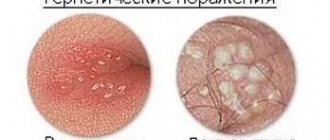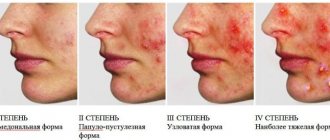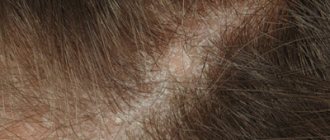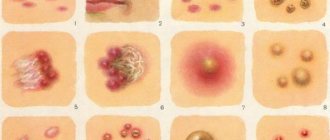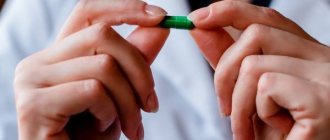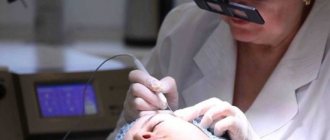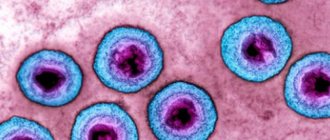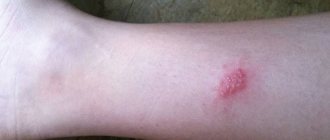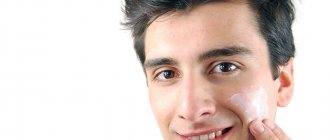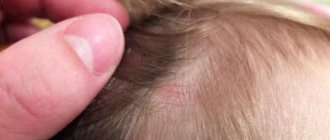If herpes appears frequently on the face, it means that there is a failure in the body’s immune system. What kind of disorder has brought the herpes simplex virus (HSV) into an active state, only a doctor can say after an examination. This virus affects most of the world's population. It cannot be cured. The infection strain is integrated into the human genome, after which the immune system can no longer remove it. The virus penetrates the nerve endings of the skin and exists there hidden until the immune system weakens.
What does herpes look like on the face?
Herpetic rashes on the face (in the lips, on the mucous membranes of the nose and mouth, on the cheeks and chin, on the eyelids) become clearly visible when they go through all stages of their development. Symptoms of herpesvirus progression:
- 1st stage. At the site where herpes appears, the skin becomes inflamed, and the person begins to feel a slight tingling and itching on the face.
- 2nd stage. The inflamed skin begins to hurt, and blisters with liquid form on it.
- 3rd stage. The blisters burst, their contents pour out, and painful ulcers appear on the face.
- 4th stage. The leaked liquid dries out and forms a loose crust.
The initial stage of herpes is the period when a person has enough time to prevent the development of a painful and long-healing cold on the face.
Localization symptoms
The incubation period for herpes simplex is 10 days. The disease begins with a characteristic specific tingling and burning sensation on the skin of the forehead. Then this place turns red, becomes covered with red spots, swells, the burning and itching intensifies.
General symptoms appear:
- signs of intoxication: weakness, fever;
- unstable stool;
- inflammation of the lymph nodes.
After a day or two, small pustules appear on the skin of the patient’s forehead, which fill with a cloudy liquid within a few days, then merge into a single affected area in the form of ulcers. All this is very painful.
Then, in the period from the 4th to the 9th day, the bubbles begin to burst, dry out, and crusts form in their place. The pain decreases, but the itching persists. During this period, a person is especially dangerous to others; in addition, itching causes a desire to scratch the affected areas, and this leads to the spread of infection. After a week, the forehead skin recovers, it becomes pink and smooth.
Causes of herpes rashes in the facial area
When asked whether herpes is contagious or not, doctors answer in the affirmative. The infection is transmitted from person to person through contact (through objects) and airborne droplets (kissing, coughing, sneezing). The disease also passes from mother to child. Herpes infection occurs when the baby passes through the birth canal. Most often, the virus spreads between people when virus carriers do not even suspect that they pose a hidden threat to their loved ones and acquaintances.
This is explained by the fact that the strain of herpes, having penetrated under the skin (through microscopic cracks, cuts or scratches), does not manifest itself at first. During this period, the infection can only be detected through laboratory testing. Viral herpes on the face or other parts of the body appears as soon as the body's immune system is weakened by any disease. Most often this is:
- colds (ARVI, flu, acute respiratory infections);
- body hypothermia;
- prolonged exposure to the sun;
- avitaminosis;
- frequent stress and nervous disorders;
- exacerbation of chronic diseases.
Typically, a herpes virus rash on the face is caused by strain type 1 (HSV-1). But HSV-2, or genital herpes, which is sexually transmitted, can also spread to the skin of the face, mouth or nasal passage through oral sex.
Provoking factors
There are 4 factors that cause this disease and directly influence the process of its development, and they cannot be ignored, because the result of subsequent treatment depends on them.
- Factor No. 1 is the type of pathogen and the reasons for its entry into the human body.
- Factor No. 2 is the characteristics of the immune system, as well as its ability to fight viruses and various infections.
- Factor No. 3 – type of herpesvirus infection (primary or recurrent).
- Factor No. 4 – previous infectious or viral diseases, the severity of their course and treatment methods.
Perhaps the appearance of herpes on the face was an acute reaction of the body to antibiotics or drugs that contain powerful allergens.
What are the dangers and what are the consequences?
When the body’s immune response to the activated herpes virus is insufficient, a cold on the face takes a severe form. In this condition, a person may be hospitalized. The herpes simplex virus is an infection that, if left untreated, can affect the central nervous system. Herpes zoster causes postherpetic neuralgia, which is characterized by scars at the site of the cured shingles and pain. They are called residual herpes.
It is very important to promptly diagnose and remove the symptoms of herpes on the face in pregnant women. Primary herpes infection in newborns (neonatal herpes) can lead to serious damage to the baby's internal organs and nervous system.
If the rash appears near the eyes, it can lead to ophthalmoherpes. This pathological condition can be caused by herpes simplex virus type 1 and varicella zoster virus. Infectious agents multiply in corneal epithelial cells. They accumulate in keratocytes (cells that provide transparency to the cornea), then damage the membrane and come out, infecting healthy eye tissue along the way. In the absence of timely treatment, a person’s vision deteriorates greatly and blindness may occur.
There are unproven theories that the herpes simplex virus can provoke:
- Bell's palsy (facial nerve neuritis);
- Alzheimer's disease (one of the forms of dementia).
Drug treatment
Treatment of herpes on the face involves, first of all, visiting a doctor. The doctor will conduct an examination, interview the patient and, based on the data received, prescribe the appropriate prescription. Only a specialist should prescribe how to treat herpes on the face. Independent choice of remedy can cause complications.
The following medications help get rid of colds on the face:
- local ointments;
- vitamin complexes;
- immunomodulatory agents.
How to quickly cure herpes? When herpes appears on the face, the following ointments will help eliminate its external signs and relieve irritation and pain:
- Erythromycin. An inexpensive product that currently has no analogues. Effective due to its antibacterial properties.
- Oxolinic. This ointment relieves itching well. It's cheap and safe. Does not cause individual intolerance. The standard course of treatment is 2 weeks.
- Hyporamine. Natural based ointment with the addition of sea buckthorn. Gently eliminates herpetic lesions of the facial skin. Effectively and timely fights the effects of the virus, regardless of its location.
- Zovirax. Acyclovir-based drug. Able to overcome external manifestations and quickly cure herpes on the face. It disrupts DNA duplication of the virus, i.e. it limits reproduction. Then causes his death. However, with prolonged use it causes resistance in some strains of viruses.
- Acyclovir. The most effective remedy to combat herpes. It works similarly to Zovirax. These two ointments are based on the same active ingredients.
- Viferon. The ointment is based on the action of interferons - activators of the natural human immune system. Under the influence of the drug, cells become more resistant to the virus. This product has virtually no contraindications for use.
- Levomekol. Responsible for accelerated regeneration of damaged skin.
How many days does it take before the ointments start to work? The minimum course is a week, but often lasts longer.
How to cure ocular herpes? There are ophthalmic ointments for this:
- Acyclovir 3%.
- Vidarabine 3%.
- Zovirax.
- Tebrofen.
- Florenal.
When a cold appears, how to treat it from the inside? The following will help weaken the effect of the virus and drive it back into hibernation:
- Acyclovir.
- Zovirax.
- Valtrex.
- Famvir.
Tablets for oral use are not always prescribed: in most cases, ointments work well alone.
To get rid of herpes on the face, it is also necessary to include immunomodulators in the treatment:
- Isoprinosine.
- Galavit (at the first symptoms).
- Anaferon.
They will restore the vitality of the body and strengthen the immune response to viruses. Before treating a cold on the face with one of the selected medications, you should consult your doctor.
Please note: only comprehensive treatment can quickly eliminate herpes on the cheeks, forehead, and lips. Do not forget about regularly taking medications and using medicinal ointments: only then can we talk about a quick and effective fight against herpes.
Types of herpes viruses that cause facial rash
Herpes on the skin of the face can be caused by 3 types of viruses:
- Herpes simplex virus type 1 (HSV-1) is the most common form of the virus on the face, especially during the cold season. Popularly called a cold. Itchy rashes form on the mucous membranes of the lips, less often on the cheeks. The blisters burst approximately 2-3 days after they appear, then they crust over and stop hurting.
- Herpes simplex virus type 2 (HSV-2). Blistering rashes appear on the face in adults after unprotected oral sex. Since the herpes virus type 2, after entering the body, settles in the nerve endings, unlike HSV-1, it causes severe burning and pain for a long time. Ulcers rarely appear at the site of the lesion.
- Chickenpox or shingles virus. This strain of the virus causes chickenpox when it first enters the body. If a person had chickenpox as a child, then after a while, as a result of a severe decrease in immunity, he may develop rashes on the face or other parts of the body that are characteristic of herpes zoster. The elements of the rash are located along the nerve trunks, which is why they are painful. The risk group includes older people.
With severe immunodeficiency, herpes simplex virus type 2 and herpes zoster virus can be accompanied by an increase in body temperature to 38.5 ° C, headaches and muscle spasms.
How and with what to treat herpes on the face
Treatment of herpes on the face is carried out with medications, the effect of which is aimed at:
- reducing the incidence of herpetic eruptions;
- reducing the duration of the rash on the skin;
- reducing the severity of relapses.
It is only possible to quickly cure the herpes simplex virus within 1-2 days if we are talking about the initial stage of development of a viral infection. In other cases, it takes a long time to get rid of the rashes.
Antiviral agents
The following pharmaceuticals help with various forms of herpetic infections:
- Acyclovir - the drug is a tablet, cream, ointment. Effective against HSV-1, 2 and chickenpox or shingles.
- Valacyclovir - quickly copes with the symptoms of genital herpes and shingles. Available in tablet form.
- Famciclovir (Famvir) - available in tablets, it is prescribed for all forms of herpes.
- Penciclovir - cream is prescribed if the herpes simplex virus has damaged the skin. It is not applied to mucous membranes.
You should not apply antiherpetic ointment very thickly to inflamed areas of the skin. It is not absorbed as quickly as cream products and can stain clothes. It is applied pointwise in a thin layer.
Antiviral tablets are usually prescribed if the effect of ointment for herpes on the face is not enough.
Immunostimulating drugs
For frequent relapses of herpetic rash on the face, medications with an immunomodulatory effect are prescribed:
- Polyoxidonium - contains the active substance azoximer bromide. The product restores the body's immune barrier and activates killer T-cells, the purpose of which is to destroy viral and bacterial agents. The drug is sold in tablet and injection form.
- Lykopid is the active substance glucosaminylmuramyl dipeptide. Available in tablet form, approved for use by adults and children over 1 year of age. At the beginning of treatment, body temperature may increase to 37.9°C, which is normal. The drug increases the ability of immune system cells to destroy viruses.
- Derinat - the active component is sodium deoxyribonucleate. The medicine is sold in liquid form (spray, nasal drops, injection solution) and helps activate cellular immunity. The drug is approved for use by newborn babies, pregnant and lactating women.
- Interferons are a group of antiviral immunostimulating drugs. Their main component is interferon (the human body produces this protein when a virus is introduced). The drugs are available in different dosage forms. For herpes on the face, patients are prescribed drugs such as Viferon, Inferon, Reaferon.
Immunostimulating drugs are taken only in combination with antiherpes drugs. The haphazard use of such drugs, especially if the patient selected the dosage independently, can cause harm to the body.
Other medicines
During treatment of the herpes simplex virus on the face, patients are prescribed local remedies along with antiviral drugs to quickly heal ulcers that appear at the site of the blisters:
- Panthenol cream - the drug stimulates tissue renewal of damaged skin, gently cleanses it of dead cells.
- Sea buckthorn oil - used for herpetic rashes on the skin of the face and oral mucosa. The product relieves inflammation and swelling, disinfects emerging ulcers, and accelerates their healing.
- Rosehip oil is effective against various forms of herpes on the face, has an antimicrobial and regenerating effect, and prevents the formation of scars.
- Corvalol - used as a lotion for mild forms of the disease. The liquid relieves swelling, dries out blisters, and disinfects sore skin.
- Pharmaceutical alcohol is effective against the initial stage of the herpes simplex virus. A cotton swab is soaked in alcohol and applied for cauterization to the inflamed area on the face.
Antibiotics for herpes on the face are prescribed only in the case of a complicated course of the disease, that is, when a bacterial or fungal infection occurs. As part of complex antiviral therapy, drugs of the cephalosporin group, macrolides and lincosamides - tablets or injections, as well as ointments with antibiotics (Levomekol, Tetracycline, Erythromycin) can be prescribed.
Folk remedies for herpes on the face
Home methods for treating herpesvirus rash on the face are quite varied, but they should be used only after consultation with the attending physician and preferably as auxiliary measures.
Alcohol tincture of propolis
How to prepare: grind 20 g of propolis, pour in 50 ml of pharmaceutical alcohol, place in a closed glass jar in a dark place for 7 days, shake the container daily.
How to treat: soak a swab or cotton swab with propolis liquid and treat the affected areas of the face. The procedure should be performed 3-4 times a day until recovery. The tincture can be taken orally daily, 20 drops with water.
Ginger juice lotions
How to prepare: peel a piece of ginger root, grate it on a fine grater, squeeze out the juice using gauze.
How to treat: soak a cotton pad with juice and apply to the sore skin of the face for 10-15 minutes. Apply lotions 2-3 times a day until recovery.
Garlic-coffee ointment
Ingredients:
- garlic - 2 cloves;
- flour - 1 tsp. with a slide;
- yogurt - 1 tbsp. l. with a slide;
- natural liquid honey - 1 tsp;
- instant coffee - 1 tsp. with a slide.
How to prepare: chop the garlic into a glass container, add flour mixed with coffee, then yogurt, previously diluted with honey. Herpes ointment should be stored on the refrigerator shelf.
How to treat: use the product to treat herpetic rashes on the face 2-3 times a day.
Herpes on the face can be quickly cured by simply applying a fresh cut of the leaves of indoor plants such as aloe, money tree (crassula), Kalanchoe, and golden mustache to the newly appearing blisters. They are applied in crushed form.
Hygiene during illness
Doctors recommend caring for facial skin affected by herpes infection as follows:
Instead of regular washing with a cosmetic cleanser, wipe healthy areas of the skin with lotion or herbal decoction. Treat inflamed areas of the face with hydrogen peroxide, then apply the ointment prescribed by the doctor. Healthy and diseased skin must be wiped with different towels or napkins, otherwise there is a high probability of infection spreading further down the face.
What not to do
When looking for recipes on how to quickly get rid of herpes on the face, you should not pay attention to tips such as piercing the blisters with a needle or steaming and removing the dried crust with your nails. All this will greatly delay recovery.
If, after all, the infection begins to progress, then the person has no choice but to disguise the herpes on the face.
This can be done on the cheeks using foundation, but it should be based on dermatological ointment, and on the lips - using lipstick.
Diagnosis of herpes
If the diagnosis of herpetic infection has not previously been established, then it is necessary to undergo examination. To detect the virus, a blood test technique is used.
Mucosal secretions can also be used as sample material. Since in the case of herpes on the forehead, the localization of the virus is far from the mucous membranes, it is recommended to donate blood from a vein for analysis.
The disease can be checked as soon as possible using a rapid test. The most popular method for detecting the virus is PCR - polymerase chain reaction.
It has the highest accuracy and allows you to detect the disease within 1-4 hours after taking the material for examination. If for various reasons this method is not suitable, an enzyme-linked immunosorbent reaction or immunofluorescence can be used.
Research results are announced within 1-10 days, depending on the distance of the laboratory from the place of analysis. After this, therapy is prescribed if the test for herpes is positive.
Features of the course of the disease and therapy in childhood
Children are most often diagnosed with type 1 virus and herpes zoster. The latter can spread not only over the skin of the body, in the area where large nerves pass, but also over the face. The cause of rashes in childhood is usually a poorly developed immune system combined with poor hygiene.
In childhood, the herpes simplex virus is difficult to tolerate, so pediatricians recommend treating the symptoms of the pathology in a timely manner. Otherwise, a viral herpes infection can cause meningitis and pneumonia. All medications for the virus should be prescribed only by a doctor; self-medication is unacceptable.
Preventive measures
To avoid the question of why blisters appeared on the lip or cheek again, after treating the rash, you must constantly follow the recommendations for the prevention of the herpes virus. You can avoid relapses of the disease if:
- Strictly observe the rules of personal hygiene.
- Constantly take care of strengthening your immune system.
- Avoid contact with people who have obvious signs of herpes.
- Eliminate the risk of hypothermia.
- Lead a healthy lifestyle, eat right.
For people whose viral herpetic rash appears on their face too often (more than 3 times a year), doctors recommend undergoing a special preventive vaccination against the virus.
